![]()
![]()
![]()
Use LEFT and RIGHT arrow keys to navigate between flashcards;
Use UP and DOWN arrow keys to flip the card;
H to show hint;
A reads text to speech;
52 Cards in this Set
- Front
- Back
|
Name the phases of interphase.
|
G1, S, and G2
|
|
|
What happens during G1?
|
The cell grows
|
|
|
What happens during G2?
|
Preparation for mitosis
|
|
|
When does the replication of DNA occur in the cell cycle?
|
S Phase of interphase
|
|
|
What are the 2 phases of cell division?
|
Mitosis and Cytokinesis
|
|
|
List the phases of Mitosis in their proper sequence.
|
Prophase, Metaphase, Anaphase, and Telophase
|
|
|
List the phases of Cell Division in their proper sequence.
|
Prophase, Metaphase, Anaphase, Telophase and Cytokinesis
|
|
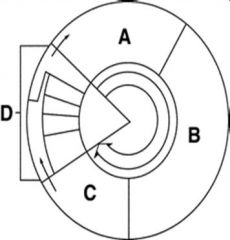
What does this picture represent?
|
The Cell Cycle
|
|

What does section A represent in the diagram?
|
G1 Phase of Interphase
|
|
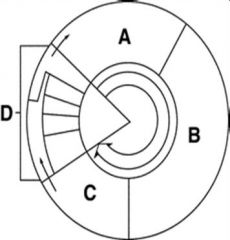
Section B is?
|
S Phase in Interphase
|
|
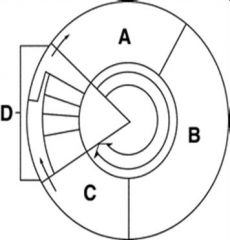
Section C is?
|
G2 Phase in interphase
|
|
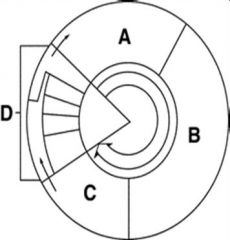
Section D is what phase?
|
M Phase or Cell Division
|
|
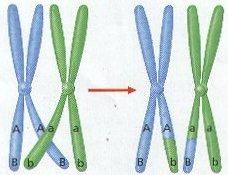
What is happening in the picture above?
|
This is called crossing-over, and results in new genetic combinations.
|
|
|
homologous chromosomes
|
The two sets of chromosomes (one set from mom, one set from dad)
|
|
|
diploid
|
Cells that contain both sets of homologous chromosomes.
|
|
|
haploid
|
gametes of sexually reproducing organisms that only contain a single set of chromosomes
|
|
|
Meiosis
|
A process of reduction division in which the number of chromosomes per cell is cut in half through the separation of homologous chromosomes in a diploid cell to form 4 genetically different haploid cells.
|
|
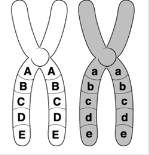
What are 3 ways you could describe the image above?
|
1 tetrad
2 Chromosomes 4 Chromatids |
|
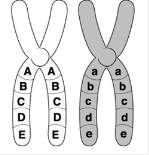
These two chromosomes are attached with what?
|
Centromere
|
|
|
A person who has cancer has lost the ability to control _______________________?
|
Cell Division
|
|
|
How does sexual reproduction increase diversity?
|
The recombination of genes from both parents.
|
|
|
Mitosis results in the formation of what kind of cells?
|
2 identical cells
Body cells |
|
|
Meiosis results in the formation of what kind of cells?
|
4 geneticaly different cells
Sex Cells (gametes) |
|
|
Define Genetics
|
Branch of Science that explains HOW traits are inherited
|
|
|
Heredity
|
The study of traits that are transmitted from one generation to the next.
|
|
|
Traits
|
Characteristics that are inherited
|
|
|
Genes
|
Sections of chromosomes (DNA) which determine the traits that will be inherited.
|
|
|
Law of Dominance
|
One gene prevents the expression of the other
|
|
|
Law of Segregation
|
During meiosis, the pairs of genes separate so that each gamete receives only one gene for each trait.
|
|
|
Dominant Gene
|
Always expressed if present for a trait
Dominant Allele = Capital Letter (B) |
|
|
Recessive Gene
|
Only expressed if two are present for a trait
Recessive Allele = lowercase letter (b) |
|
|
Genotype
|
combination of the two alleles (genes)
Ex TT, Tt, tt, RR, Rr, rr |
|
|
Phenotype
|
physical features; what they look like… based on the genotype
Ex. Tall, Short, Round, Wrinkled |
|
|
Homozygous
|
2 of the same alleles for the same trait
Ex. TT, tt, RR, rr |
|
|
Heterozygous
|
Each allele is different for the same trait
Ex. Tt, Rr |
|
|
What are punnett squares used to determine?
|
Use to determine the PROBABILITY of the offspring’s genotypes
This does NOT determine how many offspring will be produced, or tell exactly what the offspring’s genotype and phenotype will look like… just a PROBABILITY!!! |
|
|
What is incomplete dominance?
|
Produce offspring with a third phenotype that is a blending of the parental traits (pink)
|
|
|
How do you find surface area?
|
Surface area = numer of surfaces x length x width
|
|
|
How do you find Volume?
|
Volume = Length x width x height
|
|
|
How do you find the surface area to volume ratio?
|
Surface area to volume ratio = surface area/volume
|
|
|
Does each cell get larger?
OR Do cells divide to create more cells? |
Cells divide to produce more cells
|
|
|
How many cells begin and end for mitosis?
|
1 begins and 2 identical diploid cells end
|
|
|
How many cells begin and end for meiosis?
|
1 begins and 4 genetically different gamete cells end
|
|
|
Name 3 problems that occur if a cell is too big.
|
Make more demands on its DNA (DNA overload)
Have more trouble moving materials (oxygen & water) in, and waste out Use food & oxygen more quickly |
|
|
When does crossing over occur?
|
Late in Prophase 1
|
|
|
What is independent assortment?
What does it produce? |
each member of a pair of homologous chromosomes separates independently of the members of other pairs so the results are random.
Genetically different cells |
|
|
Muscle and skin in one person have different or the same DNA?
|
Same
|
|
|
What happens during Prophase?
|
chromatin condenses (becomes visible) into chromosomes, centrioles separate, spindles begin to form, nuclear envelope breaks down “Prepare”
|
|
|
What happens during Metaphase?
|
chromosomes line up in center “middle”, chromosomes connect to spindle fiber at centromere
|
|
|
What happens during Anaphase?
|
sister chromatids separate (spindle fibers pull apart) and move apart. “Away”
|
|
|
What happens during Telophase?
|
chromosomes gather at opposite ends. 2 nuclear envelopes form “Two cells”
|
|
|
What happens during Cytokinesis?
|
Cytoplasm pinches in half. Each daughter cell has identical set of chromosomes. In a plant cell, a cell plate forms to separate the 2 cells. Division ends.
|

